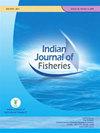印度沿海上岸长咀鱼的渔业、系统学和种群动态
IF 0.3
4区 农林科学
Q4 FISHERIES
引用次数: 0
摘要
旗鱼、马鲛、矛鱼和剑鱼通常被称为长咀鱼,是高度洄游鱼种,分布于世界各地的热带和亚热带海洋。印度沿岸的长咀鲉捕捞量呈上升趋势,预计2019年的捕捞量为14,759吨。在过去十年中,喀拉拉邦(41%)对长咀鱼上岸总量的贡献最大,其次是泰米尔纳德邦(28%)、安得拉邦(18%)、古吉拉特邦(8%)和马哈拉施特拉邦(2%)。机械刺网和钩线是长咀鲉上岸的主要渔具。2012-2019 年期间上岸的主要长咀鱼种是 Istiophorus platypterus(52.2%)、Istiompax indica(21.1%)、Makaira nigricans(7.3%)、Xiphias gladius(17.2%)和 Kajikia audax(2.3%)。其中四个物种可以很容易地通过 COI 条形码进行区分,但条纹马林鱼、K. audax 与 K. albida 的序列相似性很高,不能仅通过条形码进行区分。控制区(889 bp)提供了较好的系统发生信号,与整个线粒体基因组拓扑结构一致。长咀鱼的种群状况图显示,所有鱼种都处于发育和开发阶段。对4种长咀鲉的生长率、死亡率和开发率的估计表明,目前的捕捞率和生物量水平处于安全水平,有相当大的提升空间。关键词:CO1 条形码 开发率 大型中上层鱼类 生活史 种群状况图本文章由计算机程序翻译,如有差异,请以英文原文为准。
Fishery, systematics and stock dynamics of billfishes landed along the Indian coast
Sailfishes, marlins, spearfishes and swordfishes commonly referred to as billfishes are highlymigratory species, with a worldwide distribution in tropical and subtropical oceans. Thelandings of billfishes along the Indian coast registered an increasing trend with an estimatedlanding of 14,759 t in 2019. Kerala (41%) contributed the maximum followed by Tamil Nadu(28%), Andhra Pradesh (18%), Gujarat (8%) and Maharashtra (2%) to the total billfish landingsduring the last decade. Mechanised gillnetter cum hook and line was the major gear landingbillfishes. The major species landed during 2012-2019 were Istiophorus platypterus (52.2%),Istiompax indica (21.1%), Makaira nigricans (7.3%), Xiphias gladius (17.2%) and Kajikia audax(2.3%). Four of these species could be easily distinguished by COI barcodes but, the stripedmarlin, K. audax showed high sequence similarity with K. albida and cannot be distinguishedby barcodes alone. Control region (889 bp) provided a better phylogenetic signal, consistentwith that of the whole mitochondrial genome topology. The stock status plots of billfishesdepicted that, all the species were in the developing and exploited phase. Growth, mortalityand exploitation rates estimated for four billfishes indicated that the present fishing ratesand biomass levels are at safe levels and there is considerable scope for enhancing theirfishery. Keywords:CO1 barcodes, Exploitation rate, Large pelagics,Life history, Stock status plots
求助全文
通过发布文献求助,成功后即可免费获取论文全文。
去求助
来源期刊

Indian Journal of Fisheries
FISHERIES-
CiteScore
0.90
自引率
20.00%
发文量
0
审稿时长
6-12 weeks
期刊介绍:
Indian Journal of Fisheries is published quarterly by the Indian Council of Agricultural Research (ICAR), New Delhi. Original contributions in the field of Fish and fisheries science are considered for publication in the Journal. The material submitted must be unpublished and not under consideration for publication elsewhere.
Papers based on research which kills or damages any species, regarded as thratened/ endangered by IUCN crieteria or is as such listed in the Red Data Book appropriate to the geographic area concerned, will not be accepted by the Journal, unless the work has clear conservation objectives.
 求助内容:
求助内容: 应助结果提醒方式:
应助结果提醒方式:


